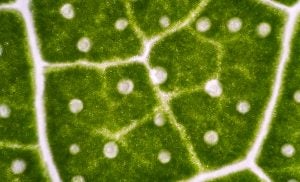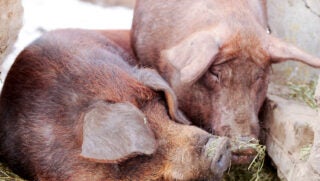“An apple a day keeps the doctor away.”
With the recent buzz surrounding probiotics, one has to wonder if the old proverb should credit something else residing in or on said apple!
Full disclosure: As seasonal and tasty as they are, there’s no evidence that apples can prevent or treat disease. However, the statement demonstrates an increasing awareness that we aren’t alone. Not from an extraterrestrial, “live long and prosper” [gratuitous Star Trek reference] standpoint, but in plants, animals, and our own guts.
Hundreds of years of scientific “truth” is being upended by the stark realization that organisms aren’t the standalone, self-sufficient units we’ve been led to believe. There’s an unheralded metacomponent — an entire ecosystem of microflora (teeny bacteria and fungi, among others) that reside on and within in symbiotic harmony.
Hit the showers all you want, we’re not as sterile as once thought. Especially our innards, where a robust microbiome (a veritable rainforest of microbe biodiversity) resides.
Maybe that’s a bit unnerving. But it’s reality. We’re a composite species — a foundational organism matched with many smaller ones, all servicing each other.
What are these interlopers doing? Are their intentions nefarious, in a super villainy sort of way?
Not at all. They’re balancing the system, providing value-added services and benefits. In this co-evolution, all parties get something out of the relationship. The relationship is so intricate, you can’t tease them apart without ecosystem collapse.
- Cows have a rumen, a multi-chambered digestive system. Teeming with microbes, it can digest (and extract energy from) otherwise indigestible cellulose. Biological systems engineering at its finest. Beat that academia.
- Termites couldn’t provide their ecosystem service (and occasional homeowner annoyance) without specialized microbes in their stomach. Feed the termites a course of antibiotics and they lose that ability. Their tailored digestion corps have been decimated. (An interesting side note: Termites have been reclassified as a type of cockroach. One suggestive line of evidence for this change was the fact that both have a similar “blend” — a stomach smoothie — of microbes!)
- In humans, don’t forget the essential E. coli (not the dreaded 0157:H7 strain that causes disease) that makes vitamin K in our intestines.
- Evidence also suggests that gut microbes can influence our mood/disposition and even susceptibility to disease.
In plants, probiotics (generally called endophytes because they reside inside the plant) similarly have a profound influence on (agroecosystem) health and productivity.
Residing in the leaves, stems, and roots, their superpowers include shoring up a plant’s defenses (crowding out the villain microbes), stimulating/enhancing growth, providing a ready-made source of nitrogen fertilizer (pulling nitrogen from the air and converting it into a plant usable form), and enhancing plant resilience during stress, like drought. For services rendered, the endophyte takes its cut of the plant’s sugars.

What’s the benefit? Plants become more self-sufficient, keeping their needs in-house with less dependence on fertilizer and pesticide inputs. With less tractor passes in the field, carbon footprints can also be reduced. In a nutshell, the embodiment of sustainable agriculture.
Interestingly, some endophytes have been found to have crossover appeal. For example, a team of scientists found that nitrogen fixing bacteria isolated from poplar and willow trees could be introduced to totally unrelated crop species — with the same suite of benefits. It seems that legumes aren’t the only plant family that can perform nitrogen fixing magic.
Developments like these have prompted the founding of whole new, transdisciplinary field called Phytobiomes. This examines the intimate relationships between plants and their microbiome for the betterment of humankind and the environment.
I’m sold, let’s isolate, characterize, and commercialize!
Yet despite their versatility, there is no one-size-fits-all endophyte concoction. Sometimes derided as snake oils, endophytes can be a mixed bag. Promising outcomes in the confines of a lab don’t always translate to the field. Another caveat is that one variety of a crop may respond favorably, while another is wholly unimpressed with a microbial suitor. Formulation is another question mark. How do you package and store living organisms for maximum shelf life without losing effectiveness? Can seed be dusted with endophytes that’ll activate upon germination?
Despite these lingering questions, we can most certainly welcome endophytes as the ag dark horse. In an era of resource scarcity and calls for smaller ag footprints, this is an exciting and timely development. A potentially inexhaustible source of indispensable, eco-friendly biological assets have yet to be discovered. Time to go bioprospecting!
Plant endophytes potentially offer a self-service ecosystem in a jug. That’s mind-boggling. Teamed with precision ag, this is a game-changer. One has to wonder if the endophyte microverse will be the next “killer app” in agriculture — a dynastic innovation on par with the Green and Gene Revolutions. In time, maybe they’ll be crowned ag royalty.
Farmers: Have you “taken” your endophyte today?
Tim Durham’s family operates Deer Run Farm — a truck (vegetable) farm on Long Island, New York. As a columnist and agvocate, he counters heated rhetoric with sensible facts. Tim has a degree in plant medicine and is an Associate Professor at Ferrum College in Virginia.



